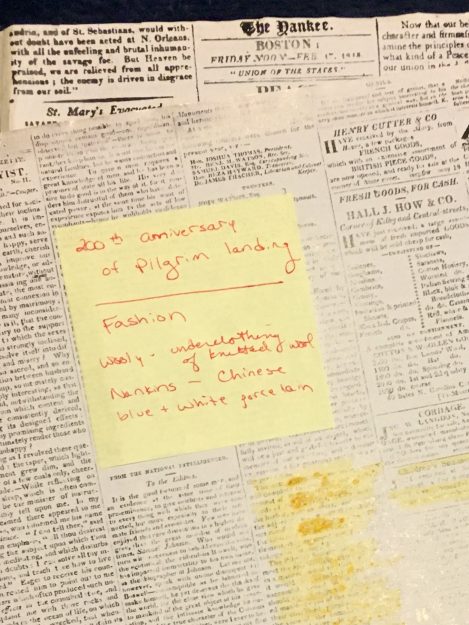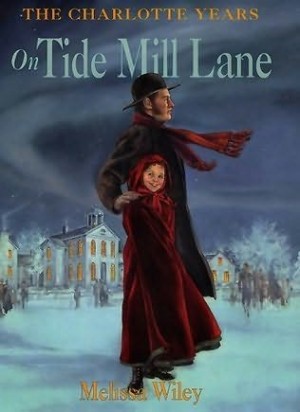
Feb. 17, 1818 Yankee article with my researcher’s sticky note still in place
I woke up to the news that the National Endowment for the Arts and National Endowment for the Humanities are among the programs slated for elimination in the new administration’s budget proposals. Not exactly a surprise, but still it smacked me in the gut, and I’ve walked around feeling ill all day.
Anyone who knows me knows why I’m sick about the scrapping of the NEA. But losing the National Endowment for the Humanities as well? Takes my breath away. If you’ve read my Charlotte books, you’ve seen one NEH project in action. The NEH funded the US Newspaper Program, which gave grants to all 50 states to preserve old, crumbling newspapers on microfilm.
Massachusetts, for example, received $770,942 in NEH support to catalog over 8000 titles, including the 1680 Publick Occurrences, America’s first newspaper. There are treasures in those archives that would have been lost to time, but for this federal funding program.
 You know that hurricane I wrote about in Tide Mill Lane? I learned of it in The Yankee—including whose roof was torn off and what other damages Roxbury folks suffered. The Brighton Cattle Show, right down to all the winners? The Yankee. The vandalism of the Bible in a Roxbury church. The first gaslights in Boston. The parade, the details of the wagons and the whole celebration. The first elephant brought to North America. All that priceless historical information came right out of newspaper articles that are available on microfilm at the Boston Public Library.
You know that hurricane I wrote about in Tide Mill Lane? I learned of it in The Yankee—including whose roof was torn off and what other damages Roxbury folks suffered. The Brighton Cattle Show, right down to all the winners? The Yankee. The vandalism of the Bible in a Roxbury church. The first gaslights in Boston. The parade, the details of the wagons and the whole celebration. The first elephant brought to North America. All that priceless historical information came right out of newspaper articles that are available on microfilm at the Boston Public Library.
Jane was still going through treatment for leukemia in NY when I was researching and writing the first two Charlotte books. I couldn’t travel. My editors at HarperCollins arranged a stipend for on-site researchers who made copies for me. “ANYTHING AT ALL you can get me from the years 1800-1820,” I asked. “The whole paper, not just the news articles. I want advertisements, editorials, everything.” Amy Sklansky and Theresa Peterson put in dozens of hours printing off copies. I pored over those riches for months. I still have them—boxes of Yankee articles on that slippery microfilm paper. I use the story about the orchard thieves (“a man named Peter Twist and two well-dressed women”) in writing workshops to this day.
That’s what the NEH did for me, and for you, if you enjoyed my books. And that’s one tiny fraction of what those tax dollars funded.
 This morning I was reading some Landmark History of the American People with Rose and Beanie, a quite fascinating chapter about Eli Whitney, and it mentioned an event that happened in 1809. That year always rings a bell for me: it was the year Laura Ingalls Wilder’s maternal grandmother, Charlotte Tucker Quiner Holbrook, was born—the Charlotte I wrote four novels about, and the mother of Caroline Quiner Ingalls (Laura’s Ma) in the Caroline books by Maria Wilkes.
This morning I was reading some Landmark History of the American People with Rose and Beanie, a quite fascinating chapter about Eli Whitney, and it mentioned an event that happened in 1809. That year always rings a bell for me: it was the year Laura Ingalls Wilder’s maternal grandmother, Charlotte Tucker Quiner Holbrook, was born—the Charlotte I wrote four novels about, and the mother of Caroline Quiner Ingalls (Laura’s Ma) in the Caroline books by Maria Wilkes.
A number of notable folks were born in that same year:
• Abraham Lincoln
• Charles Darwin
• Alfred, Lord Tennyson
• Edgar Allen Poe (The cast of Snoopy bursts forth into song in my brain: “Poe, Edgar Allen, American poet, born in eighteen hundred and nine…”)*
• Oliver Wendell Holmes
• Louis Braille
• Felix Mendelssohn
• Nicolai Gogol
…and no doubt a great many other memorable people. A lot of world-changers born that year, eh?**
* Doesn’t matter that I’ve heard the Snoopy soundtrack probably five hundred times over the course of my life (between my own high-school devotion to it and the obsession of more than one of my kids)—I still laugh every single time Charlie Brown chimes in with what he’s pretty sure are titles of Poe’s most famous works, and one of them is “Dickens’ Christmas Carol.” Hee!
** This post doesn’t really have a point. I just like to make lists.
 I am still adding to the list of Martha/Scotland-related resources, but I thought I’d get started on the Charlotte resource page as well. Expect this one to get off to a slow start and grow gradually…
I am still adding to the list of Martha/Scotland-related resources, but I thought I’d get started on the Charlotte resource page as well. Expect this one to get off to a slow start and grow gradually…
Laura Ingalls Wilder’s maternal grandmother, Charlotte Tucker Quiner Holbrook, was born in Roxbury, Massachusetts in 1809. We have birth and death records for all of Charlotte’s siblings, including the several small brothers and sisters who died in infancy. All we know as fact about Martha comes from a letter written by Laura’s youngest sister, Grace Ingalls Dow, who wrote that her great-grandmother, Martha Morse, was the daughter of a Scottish laird and married a man, Lewis Tucker, who was considered to be beneath her station. All the rest of Martha’s story as I have told it is fiction (though the details of her family’s lifestyle are historically accurate).
Charlotte left more of a paper trail, including a newspaper advertisement for seamstress services, listing a location at the intersection of Union and Warren Streets in Roxbury. Readers of Puddingstone Dam may recall that this is the location of the house the Tucker family moves to after the dam construction renders their Tide Mill Lane house a less favorable site to live.
may recall that this is the location of the house the Tucker family moves to after the dam construction renders their Tide Mill Lane house a less favorable site to live.
The history of Roxbury, Massachusetts, is a fascinating example of the advantages and casualties of American urban progress. Originally, the geographical area that became the city of Boston was a bulbous peninsula connected to the mainland by only a narrow strip of land known as “The Neck.” Roxbury, founded in 1630, was the village at the other end of the neck, and so the only land route into Boston was through Roxbury, as seen in this map of:
ROXBURY AND BOSTON IN 1775

(Compare with a map of the Boston area today.)
Gradually, the wetlands surrounding Boston to the west and south—an area known as the Back Bay—were filled in and built over. I tell a part of this story in Puddingstone Dam. Nowadays, the landscape of Boston is so drastically different from its original shape that it is hard to imagine it was ever a lonely spur of land jutting into the Atlantic. Roxbury, along with many other neighboring villages, was eventually swallowed up by Boston and is now simply a neighborhood in the great urban center.
I have loads of links relating to Roxbury, and I’ll get those entered as quickly as I can. (Although, as you know, the great event we are anxiously awaiting means that isn’t likely to be too quickly.) Here are a few to get us started:
The historic Shirley-Eustis House, former home of Royal Governor William Shirley.
Discover Roxbury.
Boston Family History‘s Roxbury section.
Still to come—resources about:
• Embroidery samplers
• Weaving
• School in Charlotte’s day
• Toys and games
• War of 1812
• Early 1800s cookery
Such as: The Old Sturbridge Village Cookbook: Authentic Early American Recipes for the Modern Kitchen —if your library has this book, you’re in for a treat. The “string-roasted chicken” recipe appears in Little House by Boston Bay
—if your library has this book, you’re in for a treat. The “string-roasted chicken” recipe appears in Little House by Boston Bay
• Lydia Marie Child, author of The American Frugal Housewife and other books
and other books
• Living history museums and villages relating to Charlotte’s time period
• What made the news in Charlotte’s day (I have many period newspaper articles to scan in)
• Clothing and fashion
• Blacksmithing
• Poetry and literature
• Music
• Holidays and celebrations
• And more!
Tags: Boston, Little House, unit studies, Charlotte Quiner, Charlotte Tucker,Laura Ingalls Wilder, children’s literature, kidlit, children’s books, books, picture books, Roxbury

 You know that hurricane I wrote about in Tide Mill Lane? I learned of it in The Yankee—including whose roof was torn off and what other damages Roxbury folks suffered. The Brighton Cattle Show, right down to all the winners? The Yankee. The vandalism of the Bible in a Roxbury church. The first gaslights in Boston. The parade, the details of the wagons and the whole celebration. The first elephant brought to North America. All that priceless historical information came right out of newspaper articles that are available on microfilm at the Boston Public Library.
You know that hurricane I wrote about in Tide Mill Lane? I learned of it in The Yankee—including whose roof was torn off and what other damages Roxbury folks suffered. The Brighton Cattle Show, right down to all the winners? The Yankee. The vandalism of the Bible in a Roxbury church. The first gaslights in Boston. The parade, the details of the wagons and the whole celebration. The first elephant brought to North America. All that priceless historical information came right out of newspaper articles that are available on microfilm at the Boston Public Library.


